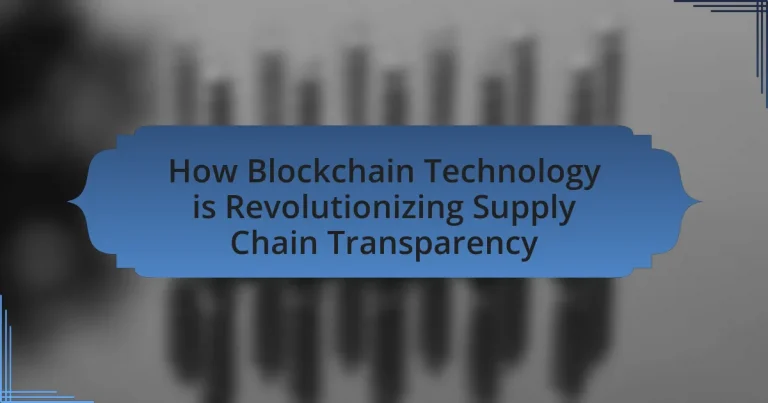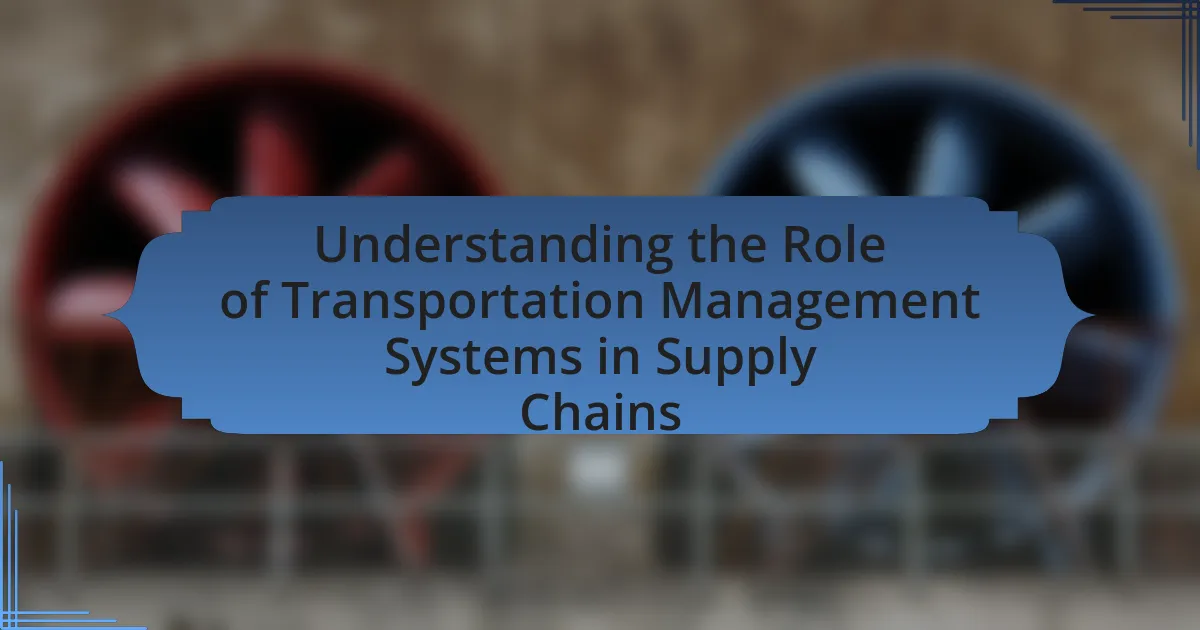Blockchain technology is a decentralized digital ledger that enhances supply chain transparency by providing an immutable record of transactions accessible to all stakeholders. This technology improves traceability, accountability, and efficiency, significantly reducing fraud and errors within supply chains. Key components of blockchain, such as decentralization, transparency, and security, facilitate real-time data sharing and verification, which are crucial for building consumer trust and brand loyalty. The article explores the functioning of blockchain in supply chains, its applications, challenges, and future trends, highlighting its transformative impact on operational practices and stakeholder engagement.
What is Blockchain Technology and How Does it Relate to Supply Chain Transparency?

Blockchain technology is a decentralized digital ledger that records transactions across multiple computers in a way that ensures the security and transparency of data. In the context of supply chain transparency, blockchain enables all parties involved in the supply chain to access a single, immutable record of transactions, which enhances traceability and accountability. For instance, according to a report by the World Economic Forum, blockchain can reduce supply chain fraud and errors by providing a transparent and verifiable history of product movement from origin to consumer. This level of transparency helps stakeholders verify the authenticity of products, monitor compliance with regulations, and improve overall efficiency in the supply chain.
How does blockchain technology function in a supply chain context?
Blockchain technology functions in a supply chain context by providing a decentralized and immutable ledger that records all transactions transparently. This technology enables all parties involved in the supply chain, including manufacturers, suppliers, and retailers, to access real-time data regarding the movement and status of goods. Each transaction is securely recorded in blocks that are linked together, ensuring that once data is entered, it cannot be altered or deleted, which enhances trust among stakeholders.
For instance, a study by the World Economic Forum highlights that blockchain can reduce supply chain fraud by up to 50% and improve the efficiency of tracking goods, as it allows for instant verification of product authenticity and origin. This transparency not only helps in mitigating risks but also streamlines operations, ultimately leading to cost savings and improved customer satisfaction.
What are the key components of blockchain technology?
The key components of blockchain technology are decentralization, transparency, immutability, and security. Decentralization allows data to be stored across a network of computers, reducing the risk of a single point of failure. Transparency ensures that all participants in the network can view the same data, fostering trust among users. Immutability means that once data is recorded on the blockchain, it cannot be altered or deleted, which enhances data integrity. Security is achieved through cryptographic techniques that protect data from unauthorized access and tampering. These components collectively enable blockchain to provide a reliable and efficient framework for various applications, including supply chain transparency.
How does decentralization enhance supply chain transparency?
Decentralization enhances supply chain transparency by distributing data across multiple nodes, allowing all participants to access and verify information independently. This structure reduces the risk of data manipulation and fosters trust among stakeholders, as each participant can trace the origin and journey of products in real-time. For instance, blockchain technology, which operates on a decentralized ledger, enables immutable record-keeping that ensures all transactions are transparent and verifiable by all parties involved. This transparency is supported by the fact that a study by Accenture found that 83% of supply chain executives believe blockchain will enhance supply chain transparency and trust.
Why is supply chain transparency important for businesses?
Supply chain transparency is crucial for businesses because it enhances trust and accountability among stakeholders. When companies provide clear visibility into their supply chains, they can better manage risks, ensure compliance with regulations, and respond swiftly to disruptions. For instance, a study by the World Economic Forum found that 79% of executives believe that supply chain transparency is essential for building customer trust and loyalty. This transparency also enables businesses to identify inefficiencies and improve sustainability practices, ultimately leading to cost savings and enhanced brand reputation.
What are the risks of a non-transparent supply chain?
The risks of a non-transparent supply chain include increased vulnerability to fraud, inefficiencies, and reputational damage. Without transparency, companies may face challenges in tracking the origin of materials, leading to potential ethical violations, such as labor exploitation or environmental harm. A study by the World Economic Forum highlights that supply chain disruptions can cost businesses up to 20% of their annual revenue, emphasizing the financial impact of inefficiencies. Additionally, lack of visibility can result in poor decision-making, as companies cannot accurately assess risks or respond to issues in real-time. This can ultimately erode consumer trust and brand loyalty, as customers increasingly demand accountability and ethical practices in sourcing.
How does transparency impact consumer trust and brand loyalty?
Transparency significantly enhances consumer trust and brand loyalty by fostering open communication and accountability. When brands provide clear information about their practices, such as sourcing, production, and sustainability efforts, consumers feel more informed and empowered in their purchasing decisions. Research indicates that 94% of consumers are likely to be loyal to a brand that offers complete transparency, as they perceive these brands as more trustworthy. Furthermore, transparency can lead to increased customer satisfaction, as consumers appreciate honesty and are more likely to advocate for brands that align with their values. This connection between transparency and consumer behavior underscores the importance of clear communication in building lasting relationships with customers.
How is Blockchain Technology Transforming Supply Chain Operations?

Blockchain technology is transforming supply chain operations by enhancing transparency, traceability, and efficiency. By providing a decentralized and immutable ledger, blockchain allows all participants in the supply chain to access real-time data regarding the movement of goods. This transparency reduces fraud and errors, as every transaction is recorded and can be verified by all parties involved.
For instance, a study by the World Economic Forum indicates that blockchain can reduce supply chain-related costs by up to 20% through improved efficiency and reduced paperwork. Additionally, companies like IBM and Maersk have implemented blockchain solutions that enable end-to-end visibility, allowing stakeholders to track shipments and verify the authenticity of products. This transformation leads to increased trust among supply chain partners and ultimately enhances customer satisfaction.
What are the specific applications of blockchain in supply chains?
Blockchain technology has specific applications in supply chains that enhance transparency, traceability, and efficiency. One key application is the tracking of goods from origin to destination, allowing stakeholders to verify the authenticity and condition of products at each stage. For instance, companies like Walmart and IBM have implemented blockchain to trace food products, reducing the time needed to identify sources of contamination from days to seconds. Another application is smart contracts, which automate and enforce agreements between parties, minimizing disputes and streamlining processes. Additionally, blockchain facilitates secure sharing of data among supply chain partners, ensuring that all parties have access to the same information, thereby reducing fraud and errors. These applications collectively contribute to improved operational efficiency and trust among supply chain participants.
How does blockchain improve traceability of products?
Blockchain improves traceability of products by providing an immutable and transparent ledger that records every transaction in the supply chain. Each product’s journey can be tracked from origin to final destination, ensuring that all stakeholders have access to the same verified information. This transparency reduces the risk of fraud and errors, as every change in ownership or status is documented and time-stamped. For instance, a study by the World Economic Forum highlights that blockchain can reduce supply chain fraud by up to 50% by enabling real-time tracking and verification of product authenticity.
What role does smart contracts play in supply chain efficiency?
Smart contracts enhance supply chain efficiency by automating processes and ensuring compliance through predefined rules. They facilitate real-time tracking of goods, reduce paperwork, and minimize human error, leading to faster transactions and improved accuracy. For instance, a study by Accenture found that implementing smart contracts can reduce contract management costs by up to 30%, demonstrating their significant impact on operational efficiency in supply chains.
What challenges does blockchain face in supply chain implementation?
Blockchain faces several challenges in supply chain implementation, including scalability, interoperability, and regulatory compliance. Scalability issues arise as blockchain networks can struggle to handle large volumes of transactions efficiently, which is critical for extensive supply chains. Interoperability challenges occur when different blockchain systems cannot communicate or share data seamlessly, hindering collaboration among various stakeholders. Additionally, regulatory compliance is a significant hurdle, as varying laws and regulations across regions can complicate the adoption of blockchain technology in supply chains. These challenges must be addressed to fully realize the potential of blockchain in enhancing supply chain transparency.
How can scalability issues be addressed in blockchain systems?
Scalability issues in blockchain systems can be addressed through various techniques such as sharding, layer 2 solutions, and consensus mechanism improvements. Sharding involves splitting the blockchain into smaller, manageable pieces, allowing multiple transactions to be processed simultaneously, which significantly increases throughput. Layer 2 solutions, like the Lightning Network for Bitcoin, enable off-chain transactions that reduce the load on the main blockchain, enhancing speed and efficiency. Additionally, improving consensus mechanisms, such as transitioning from proof-of-work to proof-of-stake, can lead to faster transaction validation and lower energy consumption. These methods have been validated by various blockchain projects, demonstrating their effectiveness in enhancing scalability.
What are the regulatory hurdles for blockchain in supply chains?
Regulatory hurdles for blockchain in supply chains include compliance with existing laws, data privacy concerns, and the need for standardization. Compliance with regulations such as the General Data Protection Regulation (GDPR) poses challenges, as blockchain’s immutable nature can conflict with the right to be forgotten. Data privacy concerns arise from the transparency of blockchain, which may expose sensitive information. Additionally, the lack of standardized protocols across different jurisdictions complicates interoperability and regulatory compliance, hindering widespread adoption.
What are the Future Trends of Blockchain in Supply Chain Transparency?

Future trends of blockchain in supply chain transparency include increased adoption of decentralized networks, enhanced traceability through smart contracts, and integration with IoT devices. Decentralized networks will allow multiple stakeholders to access and verify data in real-time, reducing fraud and errors. Smart contracts will automate processes and ensure compliance by executing predefined conditions, thereby increasing efficiency. Additionally, the integration of IoT devices will provide real-time data on product conditions and locations, further enhancing transparency. According to a report by Gartner, by 2025, 75% of supply chain organizations will invest in blockchain technology to improve transparency and traceability.
How is the adoption of blockchain expected to evolve in the coming years?
The adoption of blockchain is expected to accelerate significantly in the coming years, driven by increasing demand for transparency and efficiency in supply chains. According to a report by Gartner, by 2025, 75% of organizations will shift from piloting to operationalizing blockchain, indicating a substantial move towards mainstream implementation. This evolution is supported by the growing recognition of blockchain’s ability to enhance traceability, reduce fraud, and streamline processes across various industries, particularly in supply chain management.
What innovations are emerging in blockchain technology for supply chains?
Innovations emerging in blockchain technology for supply chains include enhanced traceability, smart contracts, and decentralized finance (DeFi) applications. Enhanced traceability allows stakeholders to track products in real-time, ensuring authenticity and reducing fraud; for instance, companies like IBM and Walmart have implemented blockchain solutions to trace food products from farm to table, significantly improving food safety. Smart contracts automate and enforce agreements between parties, reducing the need for intermediaries and streamlining processes; an example is the use of Ethereum-based contracts in logistics to automatically release payments upon delivery confirmation. Additionally, DeFi applications are enabling more efficient financing options for supply chain participants, as seen in platforms like TradeLens, which facilitate secure and transparent transactions. These innovations collectively contribute to greater transparency and efficiency in supply chains.
How will collaboration among stakeholders shape blockchain’s future?
Collaboration among stakeholders will significantly shape blockchain’s future by fostering interoperability and trust across various sectors. When stakeholders, including businesses, regulators, and technology providers, work together, they can establish common standards and protocols that enhance the functionality of blockchain systems. For instance, the Hyperledger project, which involves multiple organizations, aims to create open-source blockchain frameworks that facilitate collaboration and innovation. This collective effort can lead to improved supply chain transparency, as seen in initiatives like IBM Food Trust, where multiple food industry players collaborate to trace the origin of products, thereby increasing accountability and reducing fraud. Such collaborative frameworks not only drive technological advancements but also promote regulatory compliance and consumer confidence, ultimately shaping a more robust and efficient blockchain ecosystem.
What best practices should companies follow when implementing blockchain for supply chain transparency?
Companies should follow several best practices when implementing blockchain for supply chain transparency, including establishing clear objectives, ensuring data integrity, and fostering collaboration among stakeholders. Clear objectives help define the purpose of blockchain integration, such as improving traceability or reducing fraud. Ensuring data integrity involves using secure and immutable records to maintain accurate information throughout the supply chain, which is crucial for building trust. Collaboration among stakeholders, including suppliers, manufacturers, and retailers, is essential to create a unified system that enhances transparency and accountability. These practices are supported by successful implementations, such as Walmart’s use of blockchain for tracking food products, which has demonstrated significant improvements in traceability and response times during food safety incidents.
How can organizations ensure data integrity and security in blockchain systems?
Organizations can ensure data integrity and security in blockchain systems by implementing robust cryptographic techniques, consensus mechanisms, and access controls. Cryptographic hashing secures data by creating unique identifiers for each block, making it nearly impossible to alter past transactions without detection. Consensus mechanisms, such as Proof of Work or Proof of Stake, validate transactions through network agreement, ensuring that only legitimate transactions are recorded. Additionally, access controls limit who can view or modify data on the blockchain, further enhancing security. These measures collectively protect against unauthorized access and data tampering, which are critical for maintaining trust in blockchain applications within supply chains.
What strategies can enhance stakeholder engagement in blockchain initiatives?
To enhance stakeholder engagement in blockchain initiatives, organizations should implement transparent communication, collaborative decision-making, and educational outreach. Transparent communication ensures that stakeholders are informed about project developments, fostering trust and involvement. Collaborative decision-making allows stakeholders to contribute their insights and preferences, which can lead to more tailored solutions that meet diverse needs. Educational outreach, including workshops and training sessions, equips stakeholders with the knowledge to understand blockchain technology’s benefits and applications, thereby increasing their investment in the initiative. These strategies are supported by research indicating that effective stakeholder engagement leads to higher project success rates and improved satisfaction among participants.




